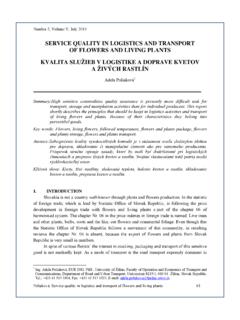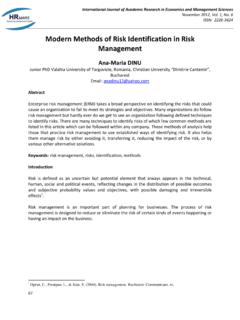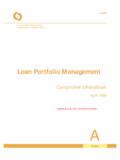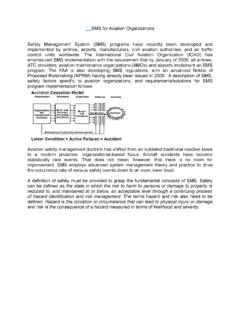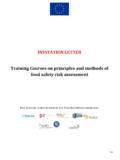Transcription of COMPONENTS OF RISK MANAGEMENT IN TRANSPORT …
1 Number 5, Volume VI, December 2011. COMPONENTS OF RISK MANAGEMENT IN TRANSPORT . company . Katar na Buganov 1, M ria Luskov 2. Summary: Continuing problems of TRANSPORT companies in consequence of financial and economic crisis are clear-cut evidence that risk MANAGEMENT in TRANSPORT companies plays a very important role to achieve long term competitiveness and profitability. The paper is dealing with business risks and risk MANAGEMENT in TRANSPORT companies. Key words: risk, risk factors, risk analysis, risk MANAGEMENT , TRANSPORT company INTRODUCTION. Today's constantly changing business world becomes volatile, unpredictable and more complex every day. Integrated Europe brings together with TRANSPORT development also greater business, creates longer carried distances and enables greater performances. TRANSPORT companies have possibility to realize their business ideas, support their own competitiveness and obtain profitable position on the market.
2 At the same time these companies, that have a key role in economic activities, have to face new risk horizons and grapple with the changes brought about by a post-down economy. Although historically, business has viewed risks as a necessary evil that should be minimized or mitigated, modern risk MANAGEMENT conceptions provide mechanisms that except identification of risks representing potential pitfalls identify also risks that bring opportunities. 1. BUSINESS ENVIRONMENT AND BUSINESS risks . Globalization brings huge opportunities for today business environment. Borders are coming down, new markets are opening up and technology development drives the growth. New competitive environment and market internationalization offer to TRANSPORT companies great opportunities. Business now operates in an entirely different environment compared with just 15 years ago.
3 Many companies perceive a rise in the number and severity of the risks they face. Nearly all operational tasks and processes are now viewed through the prism of risk. The term risk has become shorthand for any company activity. But it is not possible to create business that does not take risks . Therefore companies are looking for more effective and efficient ways to deal with the risks that are everywhere. Risk, as one of the main aspects of the managerial work, is rarely managed correctly. The prejudice that risk analysis and 1. Ing. Katar na Buganov , PhD., University of ilina, Faculty of Special Engineering, Department of Crisis MANAGEMENT , Ul. 1. m ja 32, 010 26 ilina, Slovakia, Tel.: +421 41 5136748, Fax: +421 513 6620, E-mail: 2. Ing. M ria Luskov , PhD., University of ilina, Faculty of Special Engineering, Department of Crisis MANAGEMENT , Ul.
4 1. M ja 32, 010 26 ilina, Slovakia, Tel.: +421 41 5136766, Fax: +421 41 5136622, E-mail: Buganov , Luskov : COMPONENTS of risk MANAGEMENT in TRANSPORT company 36. Number 5, Volume VI, December 2011. MANAGEMENT is domain of especially great companies that can afford to pay the specialists is still persisting. Risk is inescapable in business activities and especially small and middle TRANSPORT companies, in respect of their weaker capital ratio, can neglected risk factors feel more severe than companies in other fields of business. As the example we can indicate air company Sky Europe that suffered a loss in consequence of strategically mismanagement and missing risk MANAGEMENT . TRANSPORT is an essential component of the European economy. The TRANSPORT industry at large accounts for about 7% of GDP and for over 5% of total employment in the EU of which corresponding to TRANSPORT services and the rest to TRANSPORT equipment manufacturing, while million jobs correspond to TRANSPORT services and 3 million to TRANSPORT equipment (1).
5 This data does not include TRANSPORT carried out on own account. Business in TRANSPORT is not only a survey of transfer market but especially complex package of knowledge and techniques necessary for maximum satisfying all transfer requirements. The state economic and social policy affects transfer market in greater extent than other fields. In this meaning TRANSPORT business is understood not only as economy segment but also as a part of infrastructure. Proportions of market principles and government's interventions are one of specialties characterized by transfer market. Over the last period, customer orientation as the awareness of the customer's needs, get to the forefront in TRANSPORT companies business. Companies producing tangible goods have possibility to innovate their production programme continuously and so stimulate their demand and profit.
6 TRANSPORT companies offering services have a different situation because stimulating demand for services has different character in comparison with tangible goods. It depends much more on living standard and inhabitant's style of life. Immaterial service as the result product of the TRANSPORT together with customer orientation should be considered in the strategic risk MANAGEMENT , especially within selection of suitable methods and systems for MANAGEMENT supporting. The objectives of the strategic risk MANAGEMENT have to be in accordance with the business objectives of TRANSPORT companies. The task of the strategic MANAGEMENT in TRANSPORT companies is to sustain or obtain strategic competitive advantage, to define and in certain time achieve real long-term objectives. The objective is to reduce the risk of possible failure and get the organization to the situation when it is able to foresee the changes, reply upon them, activate the changes and use them in own benefit [4,5,6].
7 2. RISK MANAGEMENT IN TRANSPORT company . Business risk MANAGEMENT in modern understanding means systematic and coordinated way of work with risk and uncertainty affected within the whole company and involving all types of risks . Single COMPONENTS of risk MANAGEMENT are shown in Figure 1. The whole process has cyclic character and should be a continuous and developing process. (2). Buganov , Luskov : COMPONENTS of risk MANAGEMENT in TRANSPORT company 37. Number 5, Volume VI, December 2011. Risk reporting & Risk reporting & Communication Communication Source: authors Fig. 1 COMPONENTS of risk MANAGEMENT in TRANSPORT company Risk reporting & communication and monitor & review are also the COMPONENTS of the risk MANAGEMENT . Risk reporting & communication is responsible for preparation of reports for internal ( Board of Directors, Advisory Committee,) and external users ( banks), too is a communication process that uses consultation to make effective decisions.
8 Importantly, consultation is not an outcome or an end in itself; it is a means by which outcomes are achieved. Consultation gives stakeholders the opportunity to influence decisions, however, it is not joint decision making, but rather an effective way to receive useful input and ensure that all relevant viewpoints are taken into account in identifying and evaluating risks . Monitor & review is concentrated on keeping or enhancing risk MANAGEMENT system in dependence on changing conditions or possible changes of company strategic objectives including risk MANAGEMENT objectives. Monitoring and review should be designed to detect both gradual and sudden change. Continuous monitoring is most likely to detect a dramatic change in a timely fashion, whereas periodic review of a particular aspect of the risk process is more oriented towards detecting trends and incremental change.
9 Methods can include data evaluation, audit and compliance measurement. The task of the initial phase of the risk MANAGEMENT - Establishing the context &. objectives of risk MANAGEMENT includes especially: specification of the internal and external environment in which the company is acting, setting the risk MANAGEMENT objectives in line with the company strategic objectives, Buganov , Luskov : COMPONENTS of risk MANAGEMENT in TRANSPORT company 38. Number 5, Volume VI, December 2011. setting the risk capacity a level of the greatest amount of the loss the company is able to survive in dependence on size and structure of its capital and ability to obtain other sources of financing, setting the risk appetite a risk level respectable for company within its risk capacity in dependence of MANAGEMENT attitude to risk and stakeholders requirements and expectations.
10 Generally risk appetite can be defined as the volatility in results that an organization and its senior MANAGEMENT accept in support of the declared company strategy, it must articulate clearly key sources of risk in a form that is readily comprehensible to non-specialists. The end product is typically expressed through a risk appetite statement, which deals with all these requirements. TRANSPORT company should consider these key questions: What risks will the company not accept? ( environmental or quality compromises). What risks will the company take on new initiatives? ( new product lines). What risks will the company accept for competing objectives? ( gross profit vs. market share?). Source: Virenfeldt, 2011. Fig. 2 Illustrating Risk Appetite in a Loss Distribution Framework Some COMPONENTS of the risk appetite can be quantified accurately with proven risk models, others are based on more subjective and qualitative evaluations.

